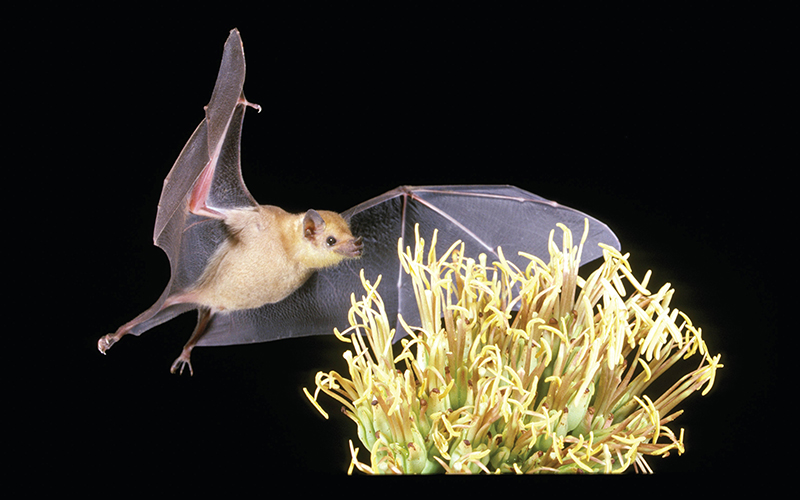COCHISE COUNTY – In the mountains 20 miles west of Willcox, 15 wind turbines stand 450 feet tall, spinning with the wind. This is the Red Horse II Wind Farm, the only wind farm operating in southern Arizona.
The wind farm is being investigated by the U.S. Justice Department’s Environmental and Natural Resources Division in connection with the death of a federally protected golden eagle and a lesser long-nosed bat. The bat was listed as endangered in 1988, and in April of this year, it was removed from the endangered species list.
The U.S. Fish and Wildlife Service opened a criminal investigation into the deaths at Red Horse II Wind Farm before referring the matter to the U.S. Justice Department, said Aislinn Maestas, a spokeswoman for the wildlife service.
The Justice Department in July turned down a public-records request on the investigation’s status and other information about the case. In an email, it said “all of these documents are protected from disclosure” under the Freedom of Information Act.
But the investigation was ongoing in July, said Todd Fogarty, a spokesman for the wind farm, adding, “Red Horse continues to fulfill information requests by the government.”
Fogarty said in an earlier email that “Red Horse Wind is committed to operating a project that both contributes to the renewable energy economy in Arizona and minimizes any adverse environmental impact.”
Red Horse farm, which began operating in 2015, reportedly killed 2,606 bats, including the one lesser long-nosed bat, during its first year of operation, according to SWCA Environmental Consultants, a firm hired to monitor the farm’s environmental impact.
Every year, more than 888,000 bats and 573,000 birds are killed at wind farms in the U.S., according to a study from the Wildlife Society Bulletin.

A lesser long-nosed bat pollinates an agave plant. The bat is found in Arizona, New Mexico and parts of California. (Photo courtesy of J. Scott Altenbach/Bat Conservation International)
Cris Hein, a biologist with Bat Conservation International who studies the impact wind farms have on the winged mammals, said bats appear intrigued by the turbines, which often leads to a fatal interaction.
“They don’t realize that they’re at risk, so they’ll fly in and out where the blades spin,” Hein said. “And even sometimes get moved around by the turbulence and still make passes back and forth. Unfortunately, there are the collisions that occur.”
Wind farms can apply for federal incidental take permits that allow the accidental killing of a certain number of birds and bats each year. Red Horse II officials did not apply for that permit because the “potential risk to birds and bats” was determined to be low when the farm began generating power. The permit would have protected the operation against prosecution for the accidental killing or taking of an endangered species.
“Red Horse Wind has been working with a local wildlife expert to conduct a monitoring program for the golden eagle and bat populations,” Fogarty said. “Regular dialogue with the U.S. Fish and Wildlife Service and Arizona Game & Fish Department is an important part of our approach to project operation. We have worked with both agencies on permitting issues and to identify measures for minimizing the impact on these species.”
In 2015, the American Wind Energy Association put forth voluntary guidelines that wind farms could practice to protect birds or bats, which included recommendations that turbine blades spin slower when bats are most active during their fall migration period.
Hein, too, has researched ways to reduce bat fatalities at wind-energy sites. Another method is to use “sonic deterrents” that keep them away from the blades.
Wind farms in general have opponents who say the sites are not sustainable. Jay Lehr, a scientist from the Heartland Institute, a conservative-libertarian think tank, said some of the negatives to wind farms are that the turbines are costly and hard to fix, so many aren’t in operation.
“It’s hard to drive anywhere in the country and not find a ridge with wind turbines on them. You will rarely find a wind farm where all the turbines are operating. Maintenance is a major problem. They break down,” Lehr said. “Somewhere down the road, the United States will just be this huge sculpture garden because there is no money to take them down when they stop operating.”
In 2016, wind energy accounted for 8 percent of the electricity supplied in the U.S., according to the U.S. Energy Information Administration. In Arizona, wind energy accounts for 0.56 percent of the electricity, according to WINDExchange.
Hein says there are positives to wind energy, which is why he works to find ways to reduce the impact on bats.
“We consume energy. Energy is obviously important and we need to move away from fossil-based energy sources. So wind energy is a component,” Hein said. “It’s growing rapidly, it’s not going anywhere, and so our kind of philosophy is to work with the industry to reduce that impact.”
Red Horse II Wind Farm generates enough energy for about 8,300 homes, according to Fogarty. Tucson Electric Power Co. buys the energy under a 20-year purchasing agreement, according to D.E. Shaw, the operator and one of the wind farm’s investors.
Since the investigation opened, the wind farm has applied for an incidental take permit for the endangered golden eagle.
-Video by Noelle Lilley
-Cronkite News reporter Tayler Brown contributed to this story.
This story is part of Elemental: Covering Sustainability, a new multimedia collaboration between Cronkite News, Arizona PBS, KJZZ, KPCC, Rocky Mountain PBS and PBS SoCal.
Follow us on Twitter.

